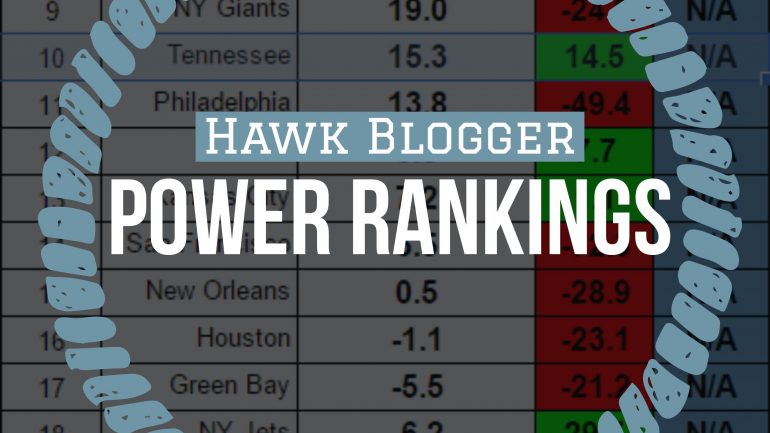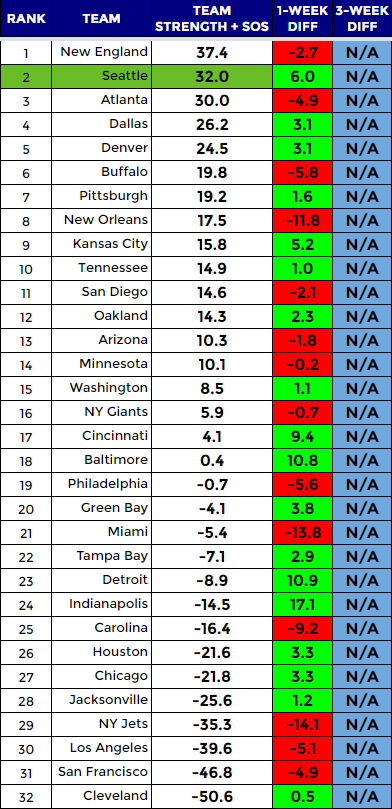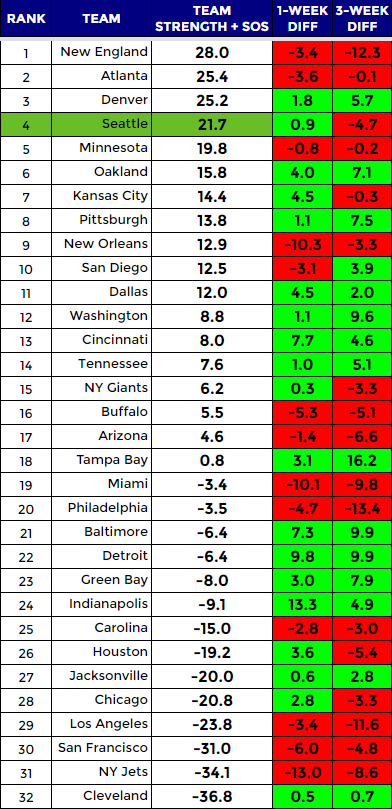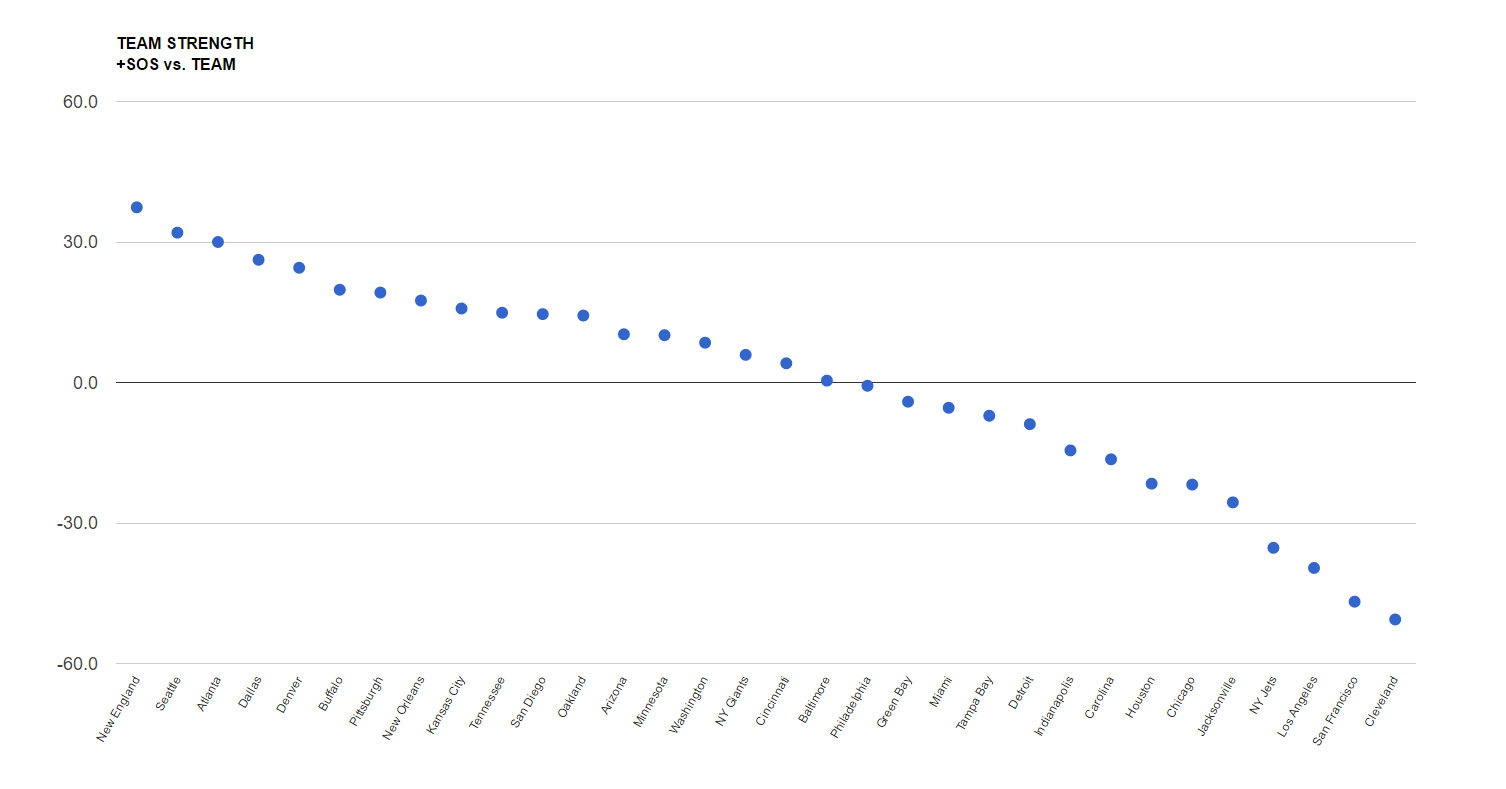Editor’s Note: NEW RANKINGS FORMULA
I rarely tinker with my rankings formula. It has proven a useful indicator of team strength, even early in the season. A few years ago I replaced yards per attempt with passer rating because of the historical significance of passer rating differential when it comes to Super Bowl winners. I also liked that it was a more holistic measure of offensive and defensive pass efficiency. More recently, I added in strength of schedule (SOS) because performance without consideration of who it was achieved against is only part of the story. I was not entirely satisfied with the formula because it left the run game almost irrelevant to the rankings.
Passer ratings range from the 60s to over 100. Yards per carry in the running game range from 2.0 to 6.0. Leaving those two numbers unweighted basically meant the running game was about 10X less important, which I don’t believe to be true. That was demonstrated this season as a team like Dallas was consistently outside the top ten in the rankings. Much of that was due to their SOS being among the worst in football, but their strong run game was not getting the credit it deserved.
I’ve updated my rankings formula, starting with the Week 11 Rankings, to increase the weighting on the run game. I will make the previous formula results available until Week 14 as a comparison, and then will phase those out. Enjoy.
POWER RANKINGS
Three weeks ago, I updated the rankings formula to increase the emphasis on run offense and defense. It was done, in part, due to my dissatisfaction with how the Dallas Cowboys were being undervalued. It is with no small dose of irony that the change helped the Seahawks stay atop the Cowboys in the rankings this week. On the strength of an emerging run game and still strong run defense, the Seahawks now own their best run differential (+0.5 yards per carry) of the season. While their 4.1 yards per carry on offense is way below the Cowboys 4.8, the Seahawks run defense at 3.6 is far better than the Cowboys at 4.2. Dallas has a modestly better run differential (+0.6 vs +0.5), but the Seahawks have a far stronger passer rating differential (+14.9 vs +7.4).
The Cowboys continue to produce remarkable points allowed numbers in spite of what measures as a poor run and pass defense. That may be due to their still bottom barrel SOS. Take last week. A truly meek Vikings offense was only able to score 15 points, but their underlying numbers were better than their typical showing against other defenses. When Dallas has faced a strong offense this year (Washington x2, Pittsburgh), they have allowed an average of 26.3 points per game. It remains to be seen whether they can hold up to a team that is strong on both offense and defense. Very few of those teams exist this year.
Seattle can be one of those teams if they find consistency on offense the rest of the way. That will be far more possible if Thomas Rawls, Russell Wilson and the running game continue their renaissance. What was the 30th ranked running attack in the league, has climbed into the teens after a torrid three week stretch that saw the reemergence of Wilson scrambles and read option runs. A Seahawks team with even an average rushing attack becomes the odds-on favorite to win a ring.
Detroit becomes the latest enigma in the rankings. They throttled a good Saints team on the road, and stand at 8-4 on the year, but are ranked 23rd here. They are overcoming remarkable odds to have the record they do. They have a negative passer rating differential while giving up a 101.9 rating to opposing quarterbacks. They have a negative run differential. They have barely outscored their opponents and sport the league’s 29th-ranked SOS. The rankings believes they are more paper tigers than lions. Time will tell.
New Rankings Formula (increased run weighting)
Old Rankings Formula (minimal run weighting)
Scatter chart (based on new formula)
I like this view as it shows tiers of strength that develop over the course of the season.
RANKINGS EXPLAINED
Power rankings are always debatable. I don’t buy into the gut feel methods most places use to determine their rankings, so I developed a formula a few years back that attempts to take at least some of the subjectivity out of the discussion. My approach was simple, I measured offensive and defensive efficiency based on the Yards Per Carry (YPC) and Yards Per Attempt (YPA), as well as points scored and points allowed. The formula to calculate “Team Strength” was as follows:
(YPC (offense) + YPA (offense) + Avg Pts/Game Scored) – (YPC (defense) + YPA (defense)+ Avg Pts/Game Allowed)
The formula has proven to be a pretty accurate predictor of success (roughly 70% of the teams ranked in the Top 10 by week 3 make the playoffs), but I am always looking for ways to improve it. I read a great article on ColdHardFootballFacts.com. There was one gem in there about predicting championship teams. The article mentioned passer rating differential as the “mother of all stats.” A full 69 of 72 champions have ranked in the Top 10 in this statistic. It is a stat after my own heart, as I believe offensive and defensive efficiency is the key measurable outside of point differential. Turnovers would factor in there as well, but I am not convinced a team has as much control over that. My power rankings use YPA and YPC differentials. I went ahead and replaced the YPA with offensive and defensive passer rating, to give me this:
(YPC (offense) + Passer Rating (offense) + Avg Pts/Game Scored) – (OPP YPC (defense) + OPP Passer Rating (defense)+ OPP Avg Pts/Game)



